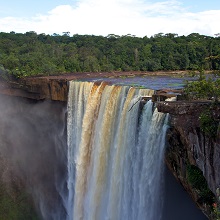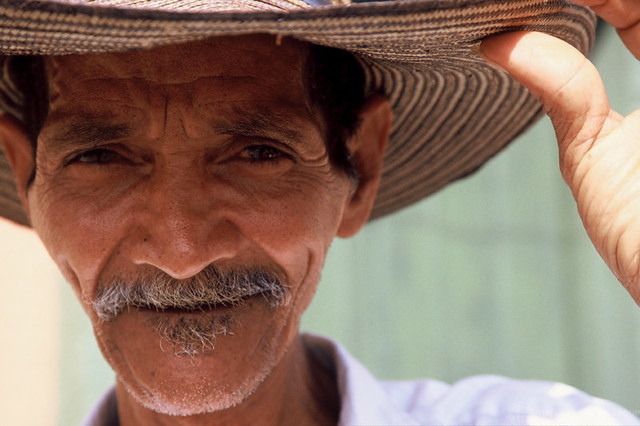The Co-operative Republic of Guyana is a small, sparsely populated South American country with abundant natural resources. Although geographically situated in South America, the country is culturally and historically connected to the Caribbean and is a founding member of the Caribbean Community (CARICOM). The country is endowed with fertile agricultural lands, valuable mineral resources - including bauxite and gold - extensive tropical forests that cover 80 percent of the country, and recently discovered large offshore oil and gas (O&G) reserves.
Guyana's estimated resources stand at over 11.2 billion oil-equivalent barrels, including an estimated 17 trillion cubic feet of associated natural gas reserves.[1] Guyanese society is ethnically and religiously diverse, encompassing Indo-Guyanese, Afro-Guyanese, Mixed-Guyanese, indigenous Amerindians, and others. Guyana has a low population density, with 90 percent of its approximately 800,000 inhabitants living on the narrow coastal plain, representing only 10 percent of the country's area. Coastal flooding–exacerbated by climate change and sea level rise–is a serious risk, as much of Guyana's population and economic activity, including in the capital, Georgetown, and most of its agriculture, are concentrated in low-lying areas along the Atlantic coast.
Guyana's GDP per capita is rapidly increasing due to oil production, which began in 2019 and reached 278,000 barrels per day (bpd) in 2022. The country is expected to remain one of the fastest growing economies with double-digit growth rates in 2023 and 2024 as additional oil fields start operation.[2] While, historically, Guyana's GDP per capita was among the lowest in South America, extraordinary economic growth since 2020, averaging 42.3 percent over the last three years, brought GDP per capita to over US$18,199 in 2022, from US$6,477 in 2019. Real GDP is estimated to have increased by 63.4 percent in 2022, primarily driven by the expansion of oil production but also strong growth in the non-oil economy. The development of the O&G sector has allowed a notable scale-up of investment in infrastructure to support growth in other industries.
Economic diversification beyond natural resources and agriculture remains a challenge, particularly in the growing O&G sector. Oil exports alone accounted for about 88 percent of total exports in 2022. Excluding oil, sugar, gold, bauxite, shrimp, timber, and rice represent nearly 90 percent of the country's non-oil exports. To reduce reliance on the oil sector and, therefore, vulnerability to price shocks, structural reforms are critical to diversify the domestic economy and ensure sustainable and broad-based growth.
Guyana has experienced a decline in poverty over the past decade from 60.9 percent in 2006 to 48.4 percent in 2019, using a poverty line of US$5.50 per day in 2011 PPP. While the oil and non-oil economy has grown enormously since 2020, recent data to monitor progress in poverty reduction is not available. Notwithstanding these gains, poverty and social exclusion–including limited access to basic services–remain in Guyana's hinterland. The education sector in Guyana has made remarkable progress in the last 15 years in terms of access; as of 2022, Guyana achieved 91 percent and 103 percent[3] enrollment at the Nursery and Primary levels, respectively. However, learning outcomes still need to be improved across all levels. According to the 2022 Human Capital Index, a child born in Guyana just before the Coronavirus (COVID-19) pandemic will only be 50 percent as productive when she grows up as she could be if she enjoyed complete education and full health, which remains lower than the average for the Latin America and the Caribbean (LAC) region. Although the average Guyanese student is expected to complete 12.2 years of schooling, this is equivalent to only 6.8 years of learning when expressed in Learning-Adjusted Years of Schooling (LAYS). The impacts of the COVID-19 pandemic have compounded this.
Health outcomes in Guyana remain below the average for LAC and comparator countries. In 2021, the infant mortality rate was 23.2 per 1,000 live births (compared to a LAC average of 14 per 1,000 live births), and the under-5 mortality rate was 28 per 1,000 live births (compared to a LAC average of 16). Based on the recent Global Monitoring Report 2023, which reports on countries’ progress towards achieving universal health coverage as part of the monitoring for the SDGs, Guyana’s service coverage index stands at 76% in 2021. This means that about 76% of the population in Guyana can effectively access essential services. While this is an important improvement from the 65% it registered a decade ago, due, among other things, to advances in antenatal care and immunization coverage, the levels of service coverage have not advanced in recent years.
Guyana is at high risk from climate-related hazards, including increases in heavy rainfall and related occurrences of flooding, sea-level rise and storm surges, especially in coastal areas. Research shows that the impact of rising sea levels and intensified storm surges in Guyana would be among the greatest in the world, exposing 100 percent of the country's coastal agriculture and 66.4 percent of coastal urban areas to flooding and coastal erosion, with potential GDP losses projected to exceed 46.4 percent. Flooding from rainfall routinely affects residents in each of the two rainy seasons each year and the economic impacts of flooding due to rainfall are forecast to increase by around 60% by the middle of this century due to climate change. By mid-century, it is estimated that a tidal flood with a 20 percent chance of happening in any year would cause US$150M of economic damage, while a storm that has a 20 percent chance of happening in any year could flood nearly 5,000 households and over 1,000 commercial or industrial buildings in Georgetown alone, causing around US$30M of economic damage.
In response, Guyana's recently revised Low Carbon Development Strategy 2030 (LCDS) outlines substantial measures to support green and resilient growth, including increased protection for Guyana's standing forests and investments in renewable energy sources, such as hydropower and solar energy. On the adaptation side, Guyana’s Climate Resilience Strategy and Adaptation Plan sets out a comprehensive and overarching framework for building resilience to climate change impacts, the key elements of which include: emergency and extreme events/flood control and management, sea defense enhancement and maintenance, and strengthening drainage and irrigation systems.
[1] This is equivalent to 18% of discovered resources (oil and natural gas) and 32% of discovered oil worldwide since 2015.
[2] 29.0 and 38.2, respectively, according to the World Bank Group Macro Poverty Outlook, October 2023.
[3] The general enrolment rate can exceed 100 percent for reasons such as early or late entry, and/or grade repetition.




